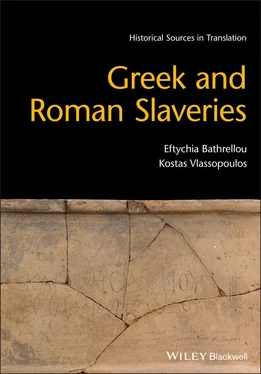Literature: Bruun 2013.
To the divine spirits: For Gnaeus Arrius Agapetus.
Arria Agapete, his mother, and Bostrychus, his father, and Elpis, his mamma , 30and Philete (?), his nurse, set this up for a most dutiful son, who well deserved it. He lived three years and 45 days.
Who is the deceased? Can we establish his status?
Who are the dedicators? Can we establish their status? How are they related to Agapetus?
What can we learn about Roman slaves and freedpersons from this passage?
2.9 CIL VI, 9983: Latin Funerary Inscription, Rome (First Century CE)
Literature: Joshel 1992.
Here lies Archelaus, manager ( vilicus ).
What was Archelaus’ legal status upon his death? Can we tell?
FINDING SLAVES AND SLAVERY IN VISUAL AND MATERIAL CULTURE
Literature: Himmelmann 1971; Kolendo 1979; Morris 1998, 2011; Schumacher 2001; Thompson 2003; George 2011; Joshel and Petersen 2014; Osborne 2017; Binsfeld and Ghetta 2019.
2.10 The Iconography of Funerary Monuments
Literature: Reilly 1989; Zanker 1993; Schumacher 2001: 65–90; von Behren 2009; Kampen 2013.
2.10.a IG I 31289: Funerary Relief with Greek Inscription, Athens (End of Fifth Century BCE) (Fig. 1)
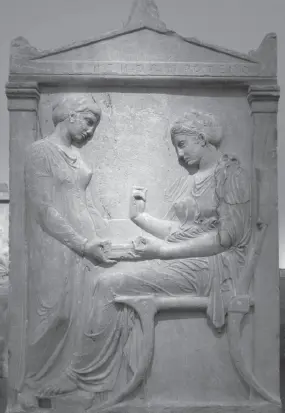
Figure 1 Funerary stele, end of fifth century BCE, Athens: National Archaeological Museum of Athens, inv. no. 3624, image provided under CC BY license from Wikimedia Commons.
Hegeso, daughter of Proxenos.
Which figure is Hegeso? How is she depicted?
Who is the other figure? How is she depicted? Can we establish her status?
What iconographic purpose does the second figure serve?
2.10.b I.S myrna 64: Funerary Relief with Greek Inscription, Smyrna, Ionia (Second Century BCE) (Fig. 2)
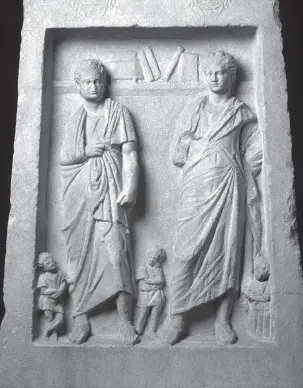
Figure 2 Funerary stele, second century BCE, Smyrna: Leiden, Rijksmuseum, inv. no. Pb. 75 Smyrna: image provided under CC BY licence by the Leiden Rijksmuseum.
honors Diodotos the younger, son of Diodotos.
Who are the two main figures? How are they represented and with what attributes?
Who are the smaller figures? How are they represented? Can we establish their status?
What iconographic purpose do the smaller figures serve?
2.10.c CIL XIII, 7684: Funerary Stele with Latin Inscription, Antunnacum, Germania Superior (First Century CE) (Fig. 3)

Figure 3 Funerary stele, first century CE, Antunnacum: image provided under CC BY licence from Wikimedia Commons.
Central pedestal : Firmus, son of Ecco, soldier of the Cohort of the Raeti, of the nation of the Montani, 36 years of age, with 14 (?) years of service. His heir set this up, according to the will.
Left pedestal : Fuscus, his slave.
Who is the central figure? How is he depicted?
Who is the left figure? How is he depicted?
Who is the right figure? How is he depicted?
Why is the slave represented in this monument? Could we identify him without the inscription?
2.11 SEG XXXVI 587: Funerary Stele with Greek Inscription, Amphipolis, Macedonia (ca. 100 CE) (Fig. 4)
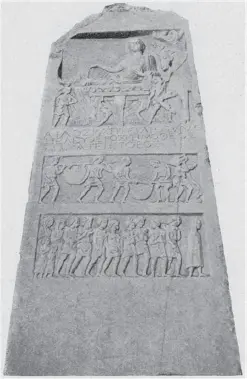
Figure 4 Funerary stele of Aulus Caprilius Timotheos, ca. 100 CE, Amphipolis: image from J. Roger, “Inscriptions de la région du Strymone,” Revue archéologique, 1945, 24, Figure 8.

Figure 8 House of the Lake, late Hellenistic period, Delos: reproduced by permission from Zarmakoupi 2016, Figure 4.10.
Literature: Finley 1977; Kolendo 1978; Duchêne 1986; Donderer and Spiliopoulou-Donderer 1993; Rizakis 2002; Bodel 2005.
Aulus Caprilius Timotheos, freedman of Aulus, slave trader.
What is the status of the deceased? What is his profession? Do you see any contradiction in these?
What is represented on the reliefs? Are there any connections between the representations and the content of the inscription?
What attitude towards the profession of the deceased is suggested by the combination of word and image on this funerary monument?
2.12 The Warren Cup: Roman Silver Vessel (First Century CE) (Fig. 5)
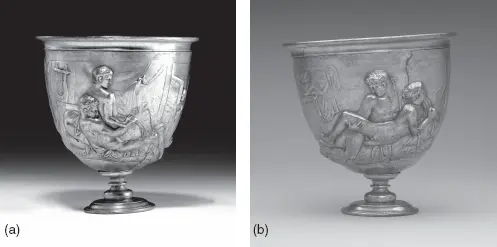
Figure 5a-b The Warren cup: Roman silver vessel, first century ce: British Museum, inv. no. 1999,0426.1.
Literature: Clarke 2003:78–91; Butrica 2005: 236–8; D. Williams 2006; Harper 2013: 25–6.
How are the two individuals having sex depicted? What differences between them can we observe in terms of age or status?
What is the third figure doing? How is he depicted?
How should we interpret his voyeuristic presence in the scene?
Can we establish the status of the three individuals depicted?
Can this artistic depiction tell us anything about slavery?
2.13 CIL VI, 1958a: Latin Funerary Inscription, Rome (First Half of First Century BCE) (Fig. 6)
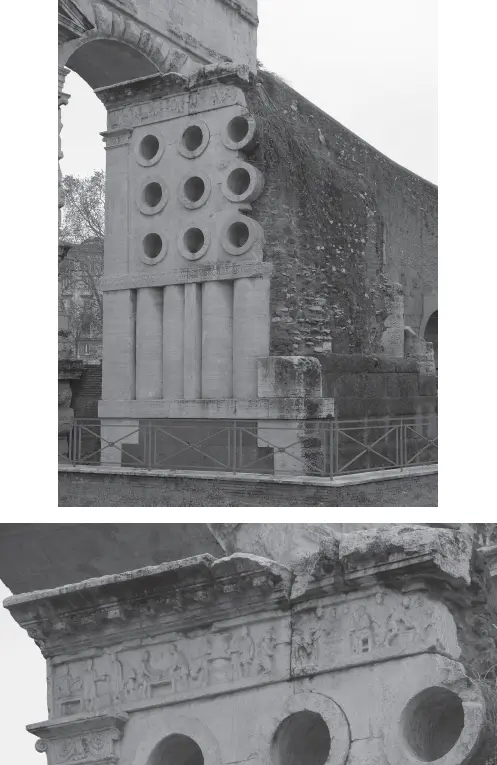
Figure 6 The funerary monument of Marcus Vergilius Eurysaces, 100–50 BCE, Rome; image provided under CC BY licence from Wikimedia Commons.
Roman freedpersons involved in crafts and trade often achieved wealth, which they tried to convert into social prestige. Roman slaves commonly bore Greek names, which they kept as their cognomina after they were manumitted, but freeborn Roman citizens could also have Greek names as cognomina . Eurysaces is a Greek name.
Literature: Petersen 2006: 84–122.
[This is the monu]ment of Marcus Vergilius Eurysaces, baker, contractor. It is evident!
What is depicted on the reliefs of this monument? What can we learn about the identity of the deceased from them?
How does the deceased identify himself?
Can we establish whether Eurysaces was a former slave? Apart from his Greek cognomen, are there other reasons to assume he had been a slave?
2.14 The Agora of the Italians: Delos, Cyclades (Second Century BCE) (Fig. 7)
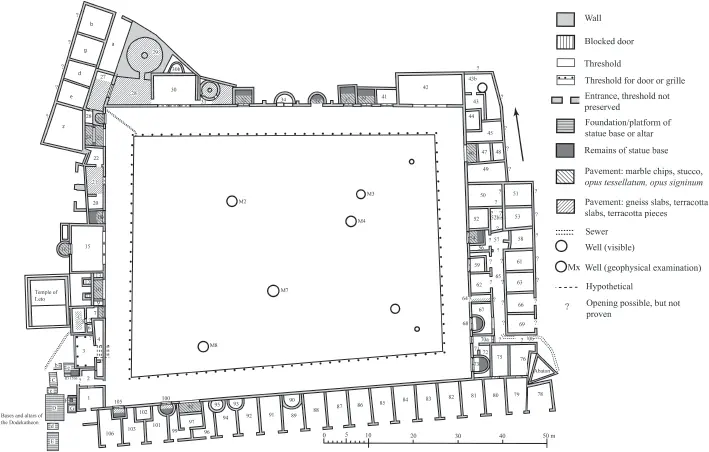
Figure 7 The agora of the Italians, ca . 100 BCE, Delos; reproduced by permission from Trümper 2009, Figure 11.
The small island of Delos was an important sanctuary, long before becoming the busiest cosmopolitan port of the late Hellenistic Mediterranean and a large slave market (cf. 8.19). Scholars have been debating whether some buildings can be identified as slave markets, and the so-called agora of the Italians has been the prime candidate. The vast unpaved courtyard enclosed 3440 m 2and could easily hold thousands of people. The porticoes round the courtyard had a second storey, which could house around a thousand persons. Rooms 28–30 housed sweat baths. The propylon (3) has been interpreted as either the entrance to the building or a platform for slave auctions.
Читать дальше
